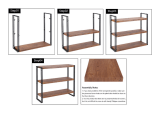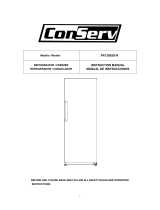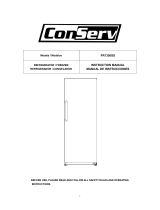
placed in different areas.
The fresh food compartment is suitable for the
storage of such foods as need not to be frozen,
the cooked food, beer, eggs, some condiments
that need cold preservation, milk, fruit juice, etc.
The crisper box is suitable for the preservation of
vegetables, fruits, etc.
The freezer compartment is suitable for the
storage of ice cream, frozen food and the foods
to be preserved for a long time.
• It’s suggested to set the temperature
at 4°C in the fridge compartment and at -18°C in
the freezer compartment if it is possible.
• For most food categories, the longest
storage time in the fridge compartment is
achieved with colder temperatures. Since some
particular products (as fresh fruits and vegetables)
may be damaged with colder temperatures, it is
suggested to keep them in the crisper drawers,
whenever present. If not present, maintain an
average setting of the thermostat.
• For frozen food, refer to the storage
time written on the food packaging. This storage
time is achieved whenever the setting respects
the reference temperatures of the compartment
(one-star -6°C, two stars -12°C, three stars -18°C)
Use of the fresh food compartment
Set the temperature of the fresh food storage
compartment between 2 ℃ ~ 8 ℃, and store the
foods that are intended for short-term storage,
or to be eaten at any time in the fresh food
compartment.
Fridge shelf: When removing the shelf, lift it up
first, and then pull it out; and when installing the
shelf, place it into position before putting it down.
(For the two-section shelf, push the first section
to the rear end, and then pull the second section
out). Keep the shelf rear flange upward, to
prevent foods from contact the liner wall. When
taking out or putting in the shelf, hold it firmly,
and handle with care to avoid damage.
Crisper box: Pull out the crisper box for access to
food. After using or cleaning the cover plate of
the crisper box, be sure to put it back onto the
crisper, so that the internal temperature of the
crisper box will not be affected.
Cautions for food storage
You’d better clean the foods and wipe them dry
before storing them inside the refrigerator.
Before foods are put in the refrigerator, it is
advisable to seal them up, so as to prevent water
evaporation to keep fresh fruits and vegetables
on one hand, and prevent taint of odor on the
other hand.
Do not put too many or too weight foods inside the
refrigerator. Keep enoughspace between foods; if
too close, the cold air flow will be blocked, thus
affecting the refrigeration effect. Do not store
excessive or overweight foods, to avoid the shelf
from being crushed. When storing the foods, keep a
distance away from the inner wall; and do not place
the water-rich foods too close to the fridge rear wall,
lest they get frozen on the inner wall.
Categorized storage of foods:Foods should be
stored by category, with the foods you eat every
day placed in front of the shelf, so that the door
open duration can be shortened and food
spoilage due to expiration can be avoid.
Energy-saving tips:Allow the hot food cool down
to the room temperature before putting it in the
refrigerator. Put the frozen food in the fresh food
compartment to thaw, using the low
temperature of the frozen food to cool the fresh
food, thus saving energy.
Storage of fruits and vegetables
In the case of refrigerating appliances with chill
compartment, a statement to the effect that
some types of fresh vegetables and fruits are
sensitive to cold and therefore are not suitable
for storage in this kind of compartment should be
made.
Use of the frozen food storage compartment
The freezer temperature is controlled below
-18 ℃, and it is advisable to store the food for
long-term preservation in the freezer
compartment, but the storage duration indicated
on the food packaging should be adhered to.
The freezer drawers are used to store food that
needs to be frozen. Fish and meat of large block
size should be cut into small pieces and packed
into fresh-keeping bags before they are evenly
distributed inside the freezer drawers.
★ Allow the hot foods to cool down to the room
temperature before putting them in the freezer
compartment.
★Do not put a glass container with liquid or the
canned liquid that is sealed in the freezer
compartment, so as to avoid burst due to volume
expansion after the liquid gets frozen up.
★Divide the food into appropriately small
portions
★You’d better pack the food up before freezing
it, and the packing bag used should be dry, in
case the packing bags are frozen together. Foods
should be packed or covered by such suitable
materials as are firm, tasteless, impervious to air
and water, non-toxic and pollution-free, to avoid
cross-contamination and transfer of odor.
Tips for shopping the frozen foods
1. When you are buying frozen food, look at
the Storage Guidelines on the packaging. You


















